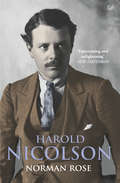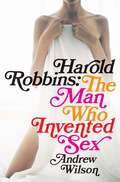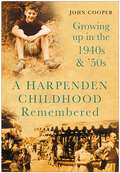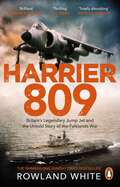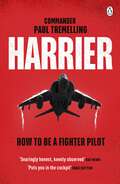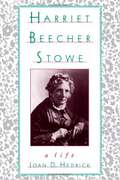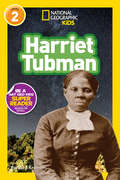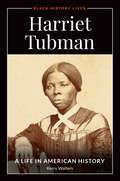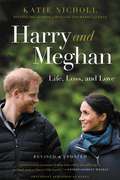- Table View
- List View
Harold Nicolson
by Norman RoseHarold Nicolson was a man of extraordinary gifts. A renowned politician, historian, biographer, diarist, novelist, lecturer, journalist, broadcaster and gardener, his position in society and politics allowed him an insight into the most dramatic events of British, indeed world, history.Nicolson's personal life was no less dramatic. Married to Vita Sackville-West, one of the most famous writers of her day, their marriage survived, even prospered, despite their both being practising homosexuals. Unashamedly elitist, bound together by their literary, social, and intellectual pursuits, moving in the refined circles of the Bloomsbury group they viewed life from the rarified peaks of aristocratic haughtiness. Few men could boast such gifts as Nicolson possessed, yet he ended his life plagued by self-doubt. 'I am attempting nothing; therefore I cannot fail,' he once acknowledged. What went wrong? It was a question that haunted Nicolson throughout his adult life. Relying on a wealth of archival material, Norman Rose brilliantly disentangles fact from fiction, setting Nicolson's story of perceived failure against the wider perspective of his times.
The Harold Nicolson Diaries: 1907-1964
by Harold NicolsonOne of the great 20th century political diaries'Brilliant, riveting stuff' TRIBUNE'One stops to marvel at the achievement. Honesty, decency, modesty, magnanimity, are stamped on every page, as evident as the wit' EVENING STANDARD'A tremendous read' SPECTATORHarold Nicolson was one of the three great political diarists of the 20th century (along with Chips Channon and Alan Clark). Nicolson was an MP (Conservative, 1935-45, who also flirted with Labour after WWII). He had previously been in the Foreign Office and attended the Paris Peace Conference in 1919, and material from this period is included in this new edition for the first time. Nicolson never achieved high office, but rarely a day went by when he didn't record what was going on at Westminster. He socialised widely, was married to the poet and author Vita Sackville-West, and together they created the famous garden at Sissinghurst. Both were bi-sexuals and had affairs outside their marriage. This new edition also draws on diary entries and letters previously considered too sensitive for inclusion. The diversity of Harold Nicolson's interests and the irony in his writing make his diary a highly entertaining record of his life and times, as well as a document of great historical value.
Harold Pinter: A Celebration
by Michael BillingtonMichael Billington's engrossing biography examines Pinter's work in the context of his life. Through extended conversations with Pinter and interviews with his friends and colleagues, Billington creates a portrait of the man as well as the artist, from Pinter's Hackney childhood to his Nobel Prize, discussing his writing for stage and screen, as well as his fiction and poetry, his acting and directing, his political activity, his friendships, his two marriages and his passion for cricket. He emerges as a man of infinite complexity whose imaginative world is shaped by his private character. This new edition includes a full transcript of the Nobel lecture, as well as an additional chapter written in the aftermath of Harold Pinter's death in December 2008. 'The foremost representative of British drama in the second half of the twentieth century.' The Swedish Academy citation on awarding Harold Pinter the Nobel Prize for Literature, 2005'Enthralling... An open-sesame into Pinter's work... A valuable book. And absorbing: I found it virtually unputdownable.' Financial Times'No reader of this book will doubt that its subject is a man of the highest artistic stature.' Sunday Telegraph
Harold Robbins: The Man Who Invented Sex
by Andrew WilsonDuring his fifty-year career Harold Robbins, the godfather of the airport novel, sold approximately 750 million copies of his books worldwide. His seventh novel, The Carpetbaggers, a steamy tale of sex, greed, and corruption loosely based on the life of Howard Hughes, is the fourth-most-read book in history. As decadent as his fiction was, however, his life was just as profligate. Over the course of his five-decade career, Robbins spent money as quickly as he earned it, reportedly wasting away $50 million on everything from booze and drugs to yachts and prostitutes. Based on extensive interviews with family members and friends, including Larry Flynt and Barbara Eden, Harold Robbins examines the remarkable life of the man who gave birth to the cult of the modern bestseller and introduced sex to the American marketplace.
Harold Rosenberg: A Critic‘s Life
by Debra Bricker BalkenDespite being one of the foremost American intellectuals of the mid-twentieth century, Harold Rosenberg (1906–1978) was utterly incapable of fitting in—and he liked it that way. Signature cane in one hand and a cigarette in the other, he cut a distinctive figure on the New York City culture scene, with his radiant dark eyes and black bushy brows. A gangly giant at six foot four, he would tower over others as he forcefully expounded on his latest obsession in an oddly high-pitched, nasal voice. And people would listen, captivated by his ideas. With Harold Rosenberg: A Critic’s Life, Debra Bricker Balken offers the first-ever complete biography of this great and eccentric man. Although he is now known mainly for his role as an art critic at the New Yorker from 1962 to 1978, Balken weaves together a complete tapestry of Rosenberg’s life and literary production, cast against the dynamic intellectual and social ferment of his time. She explores his role in some of the most contentious cultural debates of the Cold War period, including those over the commodification of art and the erosion of individuality in favor of celebrity, demonstrated in his famous essay “The Herd of Independent Minds.” An outspoken socialist and advocate for the political agency of art, he formed deep alliances with figures such as Hannah Arendt, Saul Bellow, Paul Goodman, Mary McCarthy, Jean-Paul Sartre, Willem de Kooning, and Jackson Pollock, all of whom Balken portrays with vivid accounts from Rosenberg’s life. Thoroughly researched and captivatingly written, this book tells in full Rosenberg’s brilliant, fiercely independent life and the five decades in which he played a leading role in US cultural, intellectual, and political history.
Harold Rosenberg: A Critic‘s Life
by Debra Bricker BalkenDespite being one of the foremost American intellectuals of the mid-twentieth century, Harold Rosenberg (1906–1978) was utterly incapable of fitting in—and he liked it that way. Signature cane in one hand and a cigarette in the other, he cut a distinctive figure on the New York City culture scene, with his radiant dark eyes and black bushy brows. A gangly giant at six foot four, he would tower over others as he forcefully expounded on his latest obsession in an oddly high-pitched, nasal voice. And people would listen, captivated by his ideas. With Harold Rosenberg: A Critic’s Life, Debra Bricker Balken offers the first-ever complete biography of this great and eccentric man. Although he is now known mainly for his role as an art critic at the New Yorker from 1962 to 1978, Balken weaves together a complete tapestry of Rosenberg’s life and literary production, cast against the dynamic intellectual and social ferment of his time. She explores his role in some of the most contentious cultural debates of the Cold War period, including those over the commodification of art and the erosion of individuality in favor of celebrity, demonstrated in his famous essay “The Herd of Independent Minds.” An outspoken socialist and advocate for the political agency of art, he formed deep alliances with figures such as Hannah Arendt, Saul Bellow, Paul Goodman, Mary McCarthy, Jean-Paul Sartre, Willem de Kooning, and Jackson Pollock, all of whom Balken portrays with vivid accounts from Rosenberg’s life. Thoroughly researched and captivatingly written, this book tells in full Rosenberg’s brilliant, fiercely independent life and the five decades in which he played a leading role in US cultural, intellectual, and political history.
Harold Wilson: The Unprincipled Prime Minister?: A Reappraisal of Harold Wilson
by Andrew S. Crines Kevin HicksonThis year marks the centenary of Harold Wilson’s birth, the fiftieth anniversary of his most impressive general election victory and forty years since his dramatic resignation as Prime Minister. He was one of the longest-serving premiers of the twentieth century, having won a staggering four general elections, yet, despite this monumental record, his place in Labour’s history remains somewhat ambiguous.By the end of his two periods in power, both the left and right of the party were highly critical of Wilson - the former regarding him as a traitor to socialism, the latter as contributing directly to British decline.With contributions from leading experts in the fields of political study, and from Wilson’s own contemporaries, this remarkable new study offers a timely and wide-ranging reappraisal of one of the giants of twentieth-century politics, examining the context within which he operated, his approach to leadership and responses to changing social and economic norms, the successes and failure of his policies, and how he was viewed by peers from across the political spectrum. Finally, it examines the overall impact of Harold Wilson on the development of British politics.
Harold Wilson
by Ben Pimlott Peter HennessyReissued with a new foreword to mark the centenary of Harold Wilson’s birth, Ben Pimlott's classic biography combines scholarship and observation to illuminate the life and career of one of Britain's most controversial post-war statesmen.
Harold Wilson: The Winner
by Nick Thomas-SymondsHarold Wilson is the only post-war leader of any party to serve as Britain's Prime Minister on two separate occasions. In total he won four General Elections, spending nearly eight years in Downing Street. Half a century later, he is still unbeaten, Labour's greatest ever election winner. How did he do it - and at what cost?Critics then and now have painted him as an opportunistic political calculator, even as a Soviet secret agent. In this powerful new portrait, drawing on previously unavailable sources and first-hand parliamentary insight, acclaimed biographer Nick Thomas-Symonds reveals a more complex figure. Wilson was a new kind of politician but, in his own way, this media-savvy harbinger of modernity was also a deeply traditional man, whose actions often suggest nothing less than a spiritual mission.In an intriguing paradox, Wilson, influenced by the distinctively democratic faith of his Yorkshire boyhood, united a fractured Labour Party, ushering in the cultural and social changes of the 'swinging sixties'. His was the government to decriminalise homosexuality, legalise abortion and abolish capital punishment. With a brilliant mind, sure-footed political moves and a feel for public opinion, he was a survivor who over and over again emerged from desperate crises - even, perhaps, conspiracies - to lead his party to victory. It is time at last to learn his secrets.
Harold Wilson, Denmark and the making of Labour European policy (Studies in Labour History #10)
by Matthew Broad'In 1958, Britain and Denmark both advocated closer European cooperation through the looser framework of the Free Trade Area (FTA) rather than membership of the nascent European Economic Community (EEC). By 1972, however, the situation had changed drastically. The FTA was a long-forgotten concept. Its replacement, the European Free Trade Association (EFTA), seemed economically and politically inept. Now, at the third time of asking, both countries were on the verge of joining the EEC as full members. This compelling analysis compares how the European policies of the British Labour Party and the Danish Social Democrats evolved amid this environment. Based on material from 12 archives in four countries, it updates our knowledge of key moments in both parties’ interaction with the integration story, including in the formative stages of the EEC in 1958¬–60 and the negotiations for British and Danish EEC membership in 1961–63, 1967 and 1970–72. More innovatively, this book argues that amid an array of national and international constraints the reciprocal influence exerted by Labour and the SD on each other via informal party contacts was itself a crucial determinant in European policymaking. In so doing, it sheds light on the sources of Labour European thinking, the role of small states like Denmark in the integration process, and the prominence of the Anglo-Scandinavian nexus in the broader narrative of British foreign policy in this period.'
A Harpenden Childhood Remembered: Growing Up in the 1940s & 50s
by John CooperJohn Cooper vividly recalls the dark days of the Second World War - air raids, rationing, Home Guard manoeuvres, prisoners of war on the doorstep and the excitement of VE Day - and the long, carefree days of post-war childhood that followed, when the pace of life was much gentler than today. The author recalls local shops, now long gone, such as Harriden's grocery store and Mr Lines the blacksmith, as well as Harpenden's two cinemas, in one of which he was briefly employed as a projectionist. Memories of the glittering Festival of Britain and Queen Elizabeth II's Coronation celebrations, together with a nostalgic journey back to Harpenden, round off this trip down memory lane, which will surely appeal to anyone interested in the history of Hertfordshire within living memory
Harrier 809: Britain’s Legendary Jump Jet and the Untold Story of the Falklands War
by Rowland White'Utterly brilliant: a fantastically exciting book... This really does read like the best kind of thriller. His best book yet' James Holland, author of Normandy '44April 1982. Argentina invades the Falkland Islands.In response, Britain despatches a naval task force. Eight thousand miles from home, its fate hinges on just twenty Sea Harriers against the two hundred-strong might of the Argentine Air Force.The odds against them are overwhelming.The MoD's own estimates suggest that half the Harriers will be lost in the opening days of the conflict. They need backup. Within three weeks 809 Naval Air Squadron is reformed, trained and heading south, ready for war.Not since World War Two had so much been expected of such a small band of pilots.
Harrier: How To Be a Fighter Pilot
by Paul TremellingDiscover the exhilarating first-hand account of one man's white-knuckle life as a fighter pilot with the Royal Navy Sea Harriers'Searingly honest, keenly observed, well written and extremely funny' RAF NEWS'Puts you in the cockpit for carrier landings, missile firings and some of the most intense close air support stories imaginable' MIKE SUTTON____________Few have what it takes to be a fighter pilot. From the cockpit to the crew room, the pressure is relentless. One mistake is the difference between life and death. But in the air, you'll never feel more alive . . .Paul Tremelling knows this better than anyone. With nearly 20 years of experience, he puts you in the pilot's seat in this thrilling first-hand account of a life in combat.From saving the lives of heroes under fire in Afghanistan, to performing a night trap on a pitching aircraft carrier deck, this is life as you've never experienced it before.Strap in, it's time for take-off . . .____________'An outstanding first-hand account from inside the cockpit, told with flair and humour' JOHNNY MERCER MP, author of We Were Warriors'The storytelling wouldn't be out of place in a thriller. If you are going to take one book on holiday it has to be Harrier . . . it's a superb read. You won't be able to put it down' Aerospace'Mad, bad and dangerous to know . . . Tremelling lights the burners in an extraordinary memoir that leaves most military memoirs sitting behind in the hangar' JAMES BRABAZON, author of My Friend the Mercenary'This isn't a book for the faint-hearted. It is a book for anyone who appreciates insight into how a fighter pilot trains, trains more, thinks (fast), handles the aircraft and onboard tech . . . then fights' FLYER'Tremmers puts you in the cockpit for carrier landings, missile firings and some of the most intense close air support sorties imaginable. Insightful, laced with humour, and highly recommended' MIKE SUTTON, author of Typhoon'An inspiring, enlightening and thrilling insight into how modern aviators earn their pay. The stories from Afghanistan alone are justification enough to read this brilliant book. A masterpiece' PAUL BEAVER, author of Spitfire People 'A memoir that reads like a fast-paced thriller. Harrier launches straight onto the classics shelf of aviation literature' JOHN TEMPLETON SMITH, author of White Lie
Harriet Beecher Stowe: A Life
by Joan D. Hedrick"Up to this year I have always felt that I had no particular call to meddle with this subject....But I feel now that the time is come when even a woman or a child who can speak a word for freedom and humanity is bound to speak." Thus did Harriet Beecher Stowe announce her decision to begin work on what would become one of the most influential novels ever written. The subject she had hesitated to "meddle with" was slavery, and the novel, of course, was Uncle Tom's Cabin. Still debated today for its portrayal of African Americans and its unresolved place in the literary canon, Stowe's best-known work was first published in weekly installments from June 5, 1851 to April 1, 1852. It caused such a stir in both the North and South, and even in Great Britain, that when Stowe met President Lincoln in 1862 he is said to have greeted her with the words, "So you are the little woman who wrote the book that created this great war!" In this landmark book, the first full-scale biography of Harriet Beecher Stowe in over fifty years, Joan D. Hedrick tells the absorbing story of this gifted, complex, and contradictory woman. Hedrick takes readers into the multilayered world of nineteenth century morals and mores, exploring the influence of then-popular ideas of "true womanhood" on Stowe's upbringing as a member of the outspoken Beecher clan, and her eventful life as a writer and shaper of public opinion who was also a mother of seven. It offers a lively record of the flourishing parlor societies that launched and sustained Stowe throughout the 44 years of her career, and the harsh physical realities that governed so many women's lives. The epidemics, high infant mortality, and often disastrous medical practices of the day are portrayed in moving detail, against the backdrop of western expansion, and the great social upheaval accompanying the abolitionist movement and the entry of women into public life. Here are Stowe's public triumphs, both before and after the Civil War, and the private tragedies that included the death of her adored eighteen month old son, the drowning of another son, and the alcohol and morphine addictions of two of her other children. The daughter, sister, and wife of prominent ministers, Stowe channeled her anguish and her ambition into a socially acceptable anger on behalf of others, transforming her private experience into powerful narratives that moved a nation. Magisterial in its breadth and rich in detail, this definitive portrait explores the full measure of Harriet Beecher Stowe's life, and her contribution to American literature. Perceptive and engaging, it illuminates the career of a major writer during the transition of literature from an amateur pastime to a profession, and offers a fascinating look at the pains, pleasures, and accomplishments of women's lives in the last century.
Harriet Beecher Stowe: A Life
by Joan D. Hedrick"Up to this year I have always felt that I had no particular call to meddle with this subject....But I feel now that the time is come when even a woman or a child who can speak a word for freedom and humanity is bound to speak." Thus did Harriet Beecher Stowe announce her decision to begin work on what would become one of the most influential novels ever written. The subject she had hesitated to "meddle with" was slavery, and the novel, of course, was Uncle Tom's Cabin. Still debated today for its portrayal of African Americans and its unresolved place in the literary canon, Stowe's best-known work was first published in weekly installments from June 5, 1851 to April 1, 1852. It caused such a stir in both the North and South, and even in Great Britain, that when Stowe met President Lincoln in 1862 he is said to have greeted her with the words, "So you are the little woman who wrote the book that created this great war!" In this landmark book, the first full-scale biography of Harriet Beecher Stowe in over fifty years, Joan D. Hedrick tells the absorbing story of this gifted, complex, and contradictory woman. Hedrick takes readers into the multilayered world of nineteenth century morals and mores, exploring the influence of then-popular ideas of "true womanhood" on Stowe's upbringing as a member of the outspoken Beecher clan, and her eventful life as a writer and shaper of public opinion who was also a mother of seven. It offers a lively record of the flourishing parlor societies that launched and sustained Stowe throughout the 44 years of her career, and the harsh physical realities that governed so many women's lives. The epidemics, high infant mortality, and often disastrous medical practices of the day are portrayed in moving detail, against the backdrop of western expansion, and the great social upheaval accompanying the abolitionist movement and the entry of women into public life. Here are Stowe's public triumphs, both before and after the Civil War, and the private tragedies that included the death of her adored eighteen month old son, the drowning of another son, and the alcohol and morphine addictions of two of her other children. The daughter, sister, and wife of prominent ministers, Stowe channeled her anguish and her ambition into a socially acceptable anger on behalf of others, transforming her private experience into powerful narratives that moved a nation. Magisterial in its breadth and rich in detail, this definitive portrait explores the full measure of Harriet Beecher Stowe's life, and her contribution to American literature. Perceptive and engaging, it illuminates the career of a major writer during the transition of literature from an amateur pastime to a profession, and offers a fascinating look at the pains, pleasures, and accomplishments of women's lives in the last century.
Harriet Tubman (Real Lives)
by Deborah ChancellorThe amazing story of Harriet Tubman. Born a slave in the Deep South of the US, she escaped via the Underground Railroad to the north, then went back and helped some 70 more slaves to escape, at great personal risk. She worked as a nurse for the Northern side in the Civil War and was also the first woman to lead an armed assault in that war, in a raid rescuing some 700 slaves. After the war she fought for the right of women to vote. Denied proper pay, pension or recognition for most of her life, she was buried with military honours and is now recognised as a great American hero.
Harriet Tubman: The Road to Freedom
by Catherine ClintonThe definitive biography of one of the most courageous women in American history "reveals Harriet Tubman to be even more remarkable than her legend" (Newsday).Celebrated for her exploits as a conductor on the Underground Railroad, Harriet Tubman has entered history as one of nineteenth-century America's most enduring and important figures. But just who was this remarkable woman? To John Brown, leader of the Harper's Ferry slave uprising, she was General Tubman. For the many slaves she led north to freedom, she was Moses. To the slaveholders who sought her capture, she was a thief and a trickster. To abolitionists, she was a prophet.Now, in a biography widely praised for its impeccable research and its compelling narrative, Harriet Tubman is revealed for the first time as a singular and complex character, a woman who defied simple categorization."A thrilling reading experience. It expands outward from Tubman's individual story to give a sweeping, historical vision of slavery." --NPR's Fresh Air
Harriet Tubman: A Biography (Greenwood Biographies)
by James A. McGowan William C. KashatusThis concise biography of Harriet Tubman, the African American abolitionist, explores her various roles as an Underground Railroad conductor, Civil War scout and nurse, and women's rights advocate.The legendary Moses of the Underground Railroad, Harriet Tubman was a fiery and tenacious abolitionist who organized and led African American military operations deep in the Confederacy. Harriet Tubman: A Biography relates the life story of this extraordinary woman, standing as a testament to her tenacity, drive, intelligence, and courage.In telling the remarkable story of Tubman's life, the biography examines her early years as Araminta Ross (her birth name), her escape from slavery, her activities as an Underground Railroad conductor, her involvement in the Civil War, and her role as a champion of women's rights. The book places its heroine in the broad context of her time and the movements in which she was involved, and the narrative shifts between the contextual and the personal to give the reader a strong understanding of Tubman as a woman who was shaped by, and helped to shape, the time in which she lived.
Harriet Tubman (National Geographic Readers)
by National Geographic Kids Barbara KramerFind out about the life of Harriet Tubman and how her brave actions working to "conduct" the Underground Railroad helped the Union Army in the Civil War lead more than 700 slaves to freedom.
Harriet Tubman: A Life in American History (Black History Lives)
by Professor Kerry WaltersHarriet Tubman: A Life in American History is an indispensable resource for high school and college students about the life and times of anti-slavery activist Harriet Tubman, who exemplifies how slaves took the initiative to free themselves and others.Harriet Tubman served a pivotal role in leading slaves to freedom in the decade before the Civil War. This biography offers a demythologized chronicle of her life and work with information about her life as a slave, role as conductor on the Underground Railroad, work as a military scout during the Civil War, and postwar activism for blacks and women.The book provides valuable context that situates Harriet Tubman against the backdrop of the slavery debate in antebellum America, and the hardships endured by ex-slaves in postbellum America. As such, the timeframe covers nearly a full century, from the first quarter of the 19th to the first quarter of the 20th. In addition to ten biographical chapters and a short timeline, Harriet Tubman includes an interpretive essay reflecting on her importance in American history. The volume also includes an appendix of primary documents about Tubman's life and work, a bibliography, and a number of sidebars and short commentaries embedded in the text, inviting readers to explore connections between Tubman's life and political, intellectual, and social culture.
Harriet Tubman: A Life in American History (Black History Lives)
by Professor Kerry WaltersHarriet Tubman: A Life in American History is an indispensable resource for high school and college students about the life and times of anti-slavery activist Harriet Tubman, who exemplifies how slaves took the initiative to free themselves and others.Harriet Tubman served a pivotal role in leading slaves to freedom in the decade before the Civil War. This biography offers a demythologized chronicle of her life and work with information about her life as a slave, role as conductor on the Underground Railroad, work as a military scout during the Civil War, and postwar activism for blacks and women.The book provides valuable context that situates Harriet Tubman against the backdrop of the slavery debate in antebellum America, and the hardships endured by ex-slaves in postbellum America. As such, the timeframe covers nearly a full century, from the first quarter of the 19th to the first quarter of the 20th. In addition to ten biographical chapters and a short timeline, Harriet Tubman includes an interpretive essay reflecting on her importance in American history. The volume also includes an appendix of primary documents about Tubman's life and work, a bibliography, and a number of sidebars and short commentaries embedded in the text, inviting readers to explore connections between Tubman's life and political, intellectual, and social culture.
Harrison Birtwistle: Man, Mind, Music
by Jonathan CrossLove it or loathe it, few would disagree that the music of Harrison Birtwistle stands amongst the most assured, original and challenging music ever to have been produced by a British composer. While for some the uncompromisingly modernist surface of his music can be an obstacle to closer acquaintance, for others, it is Birtwistle's articulation of deep aspects of the human psyche that continues to excite and fascinate. In this book, Jonathan Cross - a leading commentator on contemporary music - aims to uncover the sources of Birtwistle's thinking, and to present a critical account of his musical, dramatic and aesthetic preoccupations through an examination of such topics as theatre, myth, ritual, pastoral, pulse and line. He offers a range of contexts within which the music can be understood so that the curious and the initiated alike may be drawn towards new and enriching experiences of the extraordinarily powerful music of Harrison Birtwistle.
Harrison Birtwistle: Wild Tracks - A Conversation Diary with Fiona Maddocks
by Fiona Maddocks Sir Harrison Birtwistle'Anyone with the smallest interest in composition - not just concertos but novels, buildings, lives, you name it, should read this absorbing, spiky, dazzling book.' Adam Thirwell, TLS Books of the Year Harrison Birtwistle is recognised worldwide as one of the greatest of living composers, behind such works of trail-blazingly modern classical music as The Shadow of Night and The Mask of Orpheus, famously staged at the English National Opera in 1986, and winner of the Grawemeyer Award. His music is both deeply original and highly personal, yet he has always been notoriously reticent about explaining either his music or himself. In this 'conversation diary', spanning six months, he talks openly to the distinguished writer and critic Fiona Maddocks (author of the acclaimed Hildegard of Bingen: The Woman of her Age), offering rare insights into the challenges, uncertainties and rewards which have shaped his life and work since childhood, and which remain with him today as he enters his ninth decade.We see the composer in the privacy of his Wiltshire studio and garden, and in the public glare of the elite Salzburg and Aldeburgh Festivals. But mostly he is at his kitchen table, talking about the essential aspects of his life - family, cooking, cricket, landscape, pruning trees - and reflecting on the never easy-process of composition. What distinguishes him and his remarkable music is an ability to see the extraordinary in the everyday, giving rise to work that is both elemental and profound. For anyone concerned with the future of music this book is essential reading.
Harry: A Biography
by Marcia MoodyPrince Harry is arguably one of the most recognised faces in the world today, and over the years has attracted both criticism and praise. In his 29 years he has served on the frontline in Afghanistan and taken lives there, he has set up his own charities, undertaken his first solo tour representing his grandmother The Queen, has been a figure of controversy, and has won a humanitarian award. Equally at home in military uniform, black tie or jeans and baseball cap, Prince Harry certainly grabs life with both hands and rides it at 100 miles an hour.Harry: A Biography sets out to document the full, true story behind the popular prince as he steps out of the shadow of his older brother Prince William. Covering his early years, the breakdown of his parents' marriage, the death of his mother Diana, Princess of Wales, his relationship with his father and Camilla, The Duchess of Cornwall, his time at Sandhurst and serving in Afghanistan, his charity walk to the North Pole, the women in his life, his partying, and his first solo tour.Comprehensive yet entirely accessible, Harry: A Biography paints a revelatory portrait of the 'coolest' member of the royal family.
Harry: Life, Loss, and Love
by Katie NichollFrom royal expert Katie Nicholl, author of the bestselling William and Harry and Kate comes the most intimate and informative portrait yet of Prince Harry, his marriage to Meghan Markle, and how their union is modernizing the Royal Family. From his earliest public appearances as a mischievous redheaded toddler, Prince Harry has captured the hearts of royal enthusiasts around the world, while his marriage to Meghan Markle has only endeared him further. In Harry and Meghan, Britain's leading expert on the young royals offers an in-depth look at the wayward prince turned national treasure. Nicholl sheds new light on growing up royal, Harry's relationship with his mother, his troubled youth and early adulthood, and how his military service in Afghanistan inspired him to create his legacy, the Invictus Games. She uncovers new information about Harry's past relationships and reveals the true story of his romance with Meghan Markle, the smart and spirited American who captured his heart.Harry and Meghan: Life, Loss, and Love features interviews with friends, those who have worked with the prince, and former Palace aides. Nicholl reveals behind-the-scenes details about the run up to the couple's spectacular wedding day, their first tours as a married couple, and their preparations for the arrival of the youngest new royal.Harry and Meghan is a compelling portrait of the Royal Family's most popular royal couple and the story of the most gripping royal romance in a decade.Previously published as Harry: Life, Loss, and Love.
